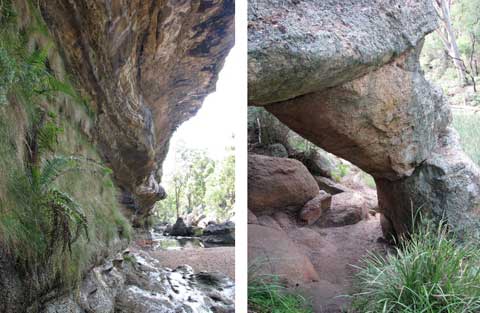Have your say! Deadline 24th February.
If ever there was proof that this mining boom is supreme madness, the irreplaceable natural wonders of the most special parts of the Goulburn River Gorge now belong to Moolarben Coal Mine.
This is 80% owned by Yancoal Australia, that is, Yanzhou, ultimately owned by the Shendong Provincial Government in China.
Between the Goulburn River Stone Cottages and the famous dripping cliff wall, The Drip, is the Corner Gorge (above); the walk between the two is stunning. (See my posts Natural Treasures and Mining Madness). Tourists and bushwalkers, locals and visitors, picnickers and photographers — all are overwhelmed by their grandeur and beauty.
Of course these ought to be national treasures, protected as part of the adjoining Goulburn River National Park, and accessible for us all to enjoy. I had assumed they were.

Community, council and government had asked Moolarben to include the transfer of The Drip and Corner Gorges to the National Park as part of their offsets package.
BUT in Moolarben’s recently released plans for its Stage Two open cut and underground mine expansion offset plans, the company have NOT done so.
This is something that the government should have mandated — in a sane state. So we have to demand they do so.
Please have your say, objecting to the MCC PPR Stage 2 plan and calling for The Drip and Corner Gorges to be transferred into the Goulburn River National Park to ensure the long term protection and appropriate management and legal public access to this regionally significant recreational, educational and cultural river corridor.
Ask the Department of Planning to appoint an independent expert panel (PAC) to fully scrutinise the strategies, assumptions and actions.
And Julia asks that ‘If you have time, add a few words why you personally value this river corridor’.
It would be good if you can c.c Save the Drip so they have an idea of how many care enough about this incredible place to fight for it.
We only have until Friday 24 February.
Email to : Dept Planning — Mining and Major Projects
Refer to: Moolarben Coal Complex Stage 2 _ Preferred Project Report: Project No: 08_0135
Additional notes from Julia:
- The offset package does not include the culturally and scenically significant river corridor known as The Drip and Corner Gorges securing its long term protection, appropriate management and on going public access.
- The permanent damage (at least 100 years) to the Goulburn River and connected groundwater system is unacceptable.
- Estimated cumulative water use by the three coal mines approximately 30-40ML/day (10-12 gigalitres/annum).
- Water use for just the Moolarben Mine estimated to be 10.55ML/day (3850 ML/annum).
- Water deficit for 23 of 24 years (up to 1990ML extra water required).
- No confidence that the groundwater modelling accurately predicts water impacts – there are significant disparities between Moolarben and Ulan Coal Mines groundwater assessments.
- Water for coal washing should be first sourced from Ulan Coal Mine surplus groundwater before any extraction from the Northern Borefield (adjacent to the Goulburn River).
- Clearing of additional 900ha of native forest (123ha EEC Box Woodland)
- Disturbance footprint of 1546 ha of native vegetation including 4.1 km of Murragamba Creek, 4.1 km of Eastern Creek and a direct impact on over 148 archaeological sites (from scatters to rock shelters).
- Biodiversity offsets are located outside the Hunter Valley catchment, do not represent “like for like’ nor replace the net loss to the bio-region or the east west vegetation corridor connecting the coastal forest to the western woodlands.
- Production 17 million tonnes of coal or 23.7 million tonnes CO2-equivalent/year of greenhouse gases fuelling further climate instability.
- Excessive noise levels e g location of the conveyor on top of ridge (must be sound attenuated and set lowered on landscape to minimise noise dispersal).
The coal mining boom has caused major devastation to the catchment with the Ulan, Wilpinjong and Moolarben Stage 1 megamines. But they are still planning more…
The full project description is here or here.
Summary of impacts: Moolarben Coal Complex Stage 2 _ Preferred Project Report